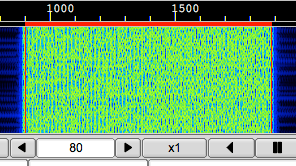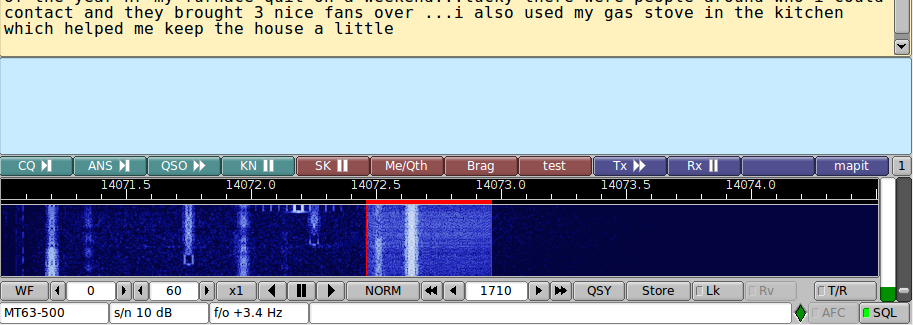MT63 is an Orthogonal Frequency Division Multiplexed mode consisting of 64 parallel carriers each carrying part of the transmitted signal. The tones are differential BPSK modulated. MT63 employs a unique highly redundant Forward Error Correction system which contributes to it robustness in the face of interference and facing. The tones have synchronous symbols, and are raised cosine moduled. This mode requires a very linear transmitter. Over-driving leads to excessive bandwidth and poorer reception.
The mode is very tolerant of tuning and fldigi will handle as much as 100 Hz of mistuning. This is very important since MT63 is often used in very low Signal to Noise ratios. There are three standard modes:
| Mode | Symbol Rate | Typing Speed | Bandwidth |
|---|---|---|---|
| MT63-500 | 5.0 baud | 5.0 cps (50 wpm) | 500 Hz |
| MT63-1000 | 10.0 baud | 10.0 cps (100 wpm) | 1000 Hz |
| MT63-2000 | 20 baud | 20.0 cps (200 wpm) | 2000 Hz |
In addition there are two interleaver options (short and long) which can be set on the MT63 configuration tab. The default calling mode is MT63-1000. If the short interleaver is used then one can expect some compromise in robustness. The long interleaver results in somewhat excessive latency (delay between overs) for keyboard chatting. MT63-1000 with the long interleaver has a latency of 12.8 seconds.
You can change from receive to transmit immediately upon seeing the other stations signal disappear from the waterfall. You do not need to wait until the receive text completes. Any remaining data in the interleaver will be flushed and the associated receive text printed quickly to the Rx pane. Tx will commence right after the buffer is flushed.
MT63 may be operated in the default fixed audio frequency mode. In this mode you are not allowed to randomly place of the signal on the waterfall. Your transmit signal, and also the received signal should be centered at 750 Hz for MT63-500, 1000 Hz for MT63-1000, and 1500 Hz for MT63-2000. If you click on the waterfall to move the tracking point it will be restored to the required position.
The default mode, MT63-1000, looks like this on fldigi's waterfall.

You can also elect to operate the MT63 modem in a "manual tune" mode (MT63 configuration tab). The manual tune allows you to place both the Rx and the Tx signal to be anywhere within the confines of your SSB bandwidth. This screen shot shows this capability:

This view also demonstrates how immune MT63 is to interference. The multiple PSK31 signals that appear on top of the MT63 signal did not degrade the decoder. MT63 is usually used above 14073 MHz to avoid the possibility of this type of mode conflict.
Edited excerpts from Pawel Jalocha's official mt63 code release
The MT63 modem is intended for amateur radio as a conversation (RTTY like) mode where one station transmits and one or more other stations can listen. In short, the modem transmits 64 tones in its baudrate specific bandwidth. The differential bipolar phase modulation is used to encode 10 bits of information per second on each tone. The user data in the form of 7-bit ASCII characters is encoded as a set of 64-point Walsh functions. The bits are interleaved over 32 symbols (3.2 seconds) to provide resistance against both pulse and frequency selective noise or fading. The character rate equals to the symbols rate thus the modem can transmit 10 7-bit characters per second.
This modem can as well run in two other modes obtained by simple time scaling, the possible modes are summarized here:
| Bandwidth | Symbol Rate | Character Rate | Interleave / Char. |
|---|---|---|---|
| 500 Hz | 5 baud | 5 char / sec | 6.4 or 12.8 sec |
| 1000 Hz | 10 baud | 10 char / sec | 3.2 or 6.4 sec |
| 2000 Hz | 20 baud | 20 char / sec | 1.6 or 3.2 sec |
For each mode the interleave factor can be doubled thus each character becomes spread over twice as long period of time.
The MT63 modem is made for single side band operation. The audio generated by the modem (sound card output) is applied to the SSB modulator. On the receiver side, the output of the SSB demodulator is put into the sound card input. The envelope of the MT63 signal is not constant as in other multi-tone systems - it is rather noise-like. One must be careful not to overdrive the transmitter.
The receiver of the MT63 is self-tuning and self-synchronizing thus the radio operator is only required to tune into the signal with +/- 100 Hz accuracy. The modem will tell the actual frequency offset after it is synchronized. The operator should not try to correct this offset unless he is able to tune the radio receiver very slowly, because MT63 as a low rate phase modulated system cannot tolerate sudden frequency changes. Signal synchronization is improved by filtering the timing measurement of the received signal. For very low signal to noise ratios you can improve the synchronization by selecting "Long Receive Integration" factor. Think of the process as a digital AFC. PSK31 does something very similar. One would expect there to be some correlation since mt63 is the equivalent of 64 simultaneous binary phase shift signals. The synchronizer filtering can be reduced to 1/2 it's normal value by selecting "Long Receive Integration". It takes twice as long for decoding to begin and the synchronizer is more immune to noise.
You probably never need to enable "Long Receive Integration" unless you are trying to receive an mt63 signal buried in the noise.
The MT63 is a synchronous system and it relies on the sampling rate to be the same at the receiver and the transmitter. At least the sampling rates should not be different by more that 10-4.
If you have calibrated your sound card to WWV, then you will meet this requirement.